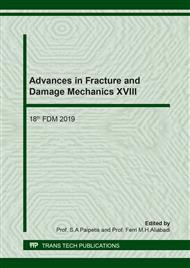p.49
p.55
p.61
p.67
p.73
p.79
p.85
p.92
p.98
A Microscale Approach for Modelling Concrete Fatigue Damage-Mechanisms
Abstract:
A micro-scale-based approach for the numerical analysis of cement-based materials, subjected to low-and high-cycle fatigue actions, is presented in this paper. The constitutive model is aimed at describing the evolving microstructural changes caused by cyclic loading protocols. More specifically, statistically representative microscopic geometries are equipped with a fracture-based model combined with a continuous inelastic constitutive law accumulating damage induced by the cyclic stress. The plastic-damage-based model is formulated combining the concepts of fracture-energy theories and damage stiffness degradations, representing the key phenomena occurring in concrete under fatigue. The paper explores the potential of the technique for assessing fatigue microcracks formation and growth, and their influence on the macroscopic behavior.
Info:
Periodical:
Pages:
73-78
Citation:
Online since:
December 2019
Price:
Сopyright:
© 2020 Trans Tech Publications Ltd. All Rights Reserved
Share:
Citation:


